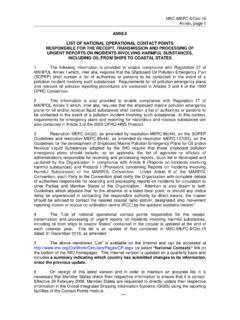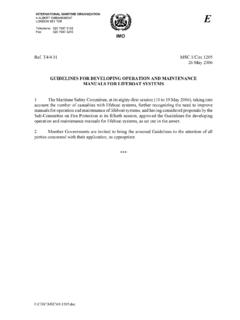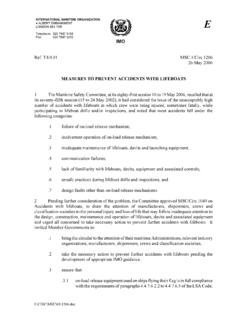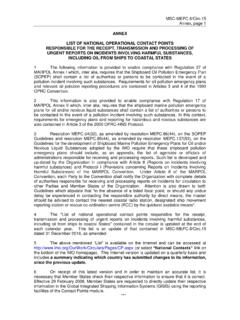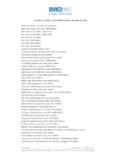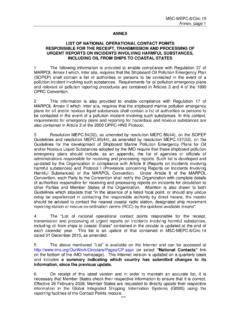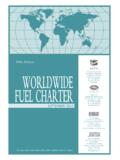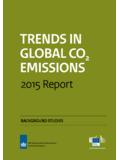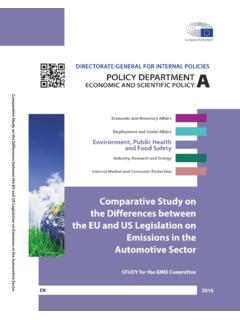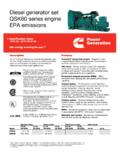Transcription of The 2020 global sulphur limit
1 Frequently Asked Questions The 2020 global sulphur limit IMO has set a global limit for sulphur in fuel oil used on board ships of m/m (mass by mass) from 1 January 2020. This will significantly reduce the amount of sulphur oxide emanating from ships and should have major health and environmental benefits for the world, particularly for populations living close to ports and coasts. When did IMO adopt regulations to control air pollution form ships? IMO has been working to reduce harmful impacts of shipping on the environment since the 1960s.
2 Annex VI to the International Convention for the Prevention of Pollution from Ships (MARPOL Convention) was adopted in 1997, to address air pollution from shipping. The regulations for the Prevention of Air Pollution from Ships (Annex VI) seek to control airborne emissions from ships ( sulphur oxides (SOx), nitrogen oxides (NOx), ozone depleting substances (ODS), volatile organic compounds (VOC) and shipboard incineration) and their contribution to local and global air pollution, human health issues and environmental problems.
3 Annex VI entered into force on 19 May 2005 and a revised Annex VI with significantly strengthened requirements was adopted in October 2008 which entered into force on 1 July 2010. The regulations to reduce sulphur oxide emissions introduced a global limit for sulphur content of ships' fuel oil, with tighter restrictions in designated emission control areas. What are the limits on sulphur in the regulations? The current global limit for sulphur content of ships' fuel oil is m/m (mass by mass). The new global limit will be m/m will apply on and after 1 January 2020.
4 When was the date of 1 January 2020 decided? The date of 1 January 2020 was set in the regulations adopted in 2008. However, a provision was adopted, requiring IMO to review the availability of low sulphur fuel oil for use by ships, to help Member States determine whether the new lower global cap on sulphur emissions from international shipping shall come into effect on 1 January 2020 or be deferred until 1 January 2025. IMO's Marine Environment Protection Committee (MEPC 70), in October 2016, decided that the limit should apply from 1 January 2020.
5 What about in Emission Control areas (ECAS)? Since 1 January 2015 the sulphur limit for fuel oil used by ships in SO x Emission Control Areas (ECAS) established by IMO has been m/m. The ECAs established under MARPOL Annex VI for SOx are: the Baltic Sea area; the North Sea area; the North American area (covering designated coastal areas off the United States and Canada); and the United States Caribbean Sea area (around Puerto Rico and the United States Virgin Islands). What will the new global limit mean for ships?
6 Under the new global cap, ships will have to use fuel oil on board with a sulphur content of no more than m/m, against the current limit of , which has been in effect since 1 January 2012. The interpretation of fuel oil used on board includes use in main and auxiliary engines and boilers. Exemptions are provided for situations involving the safety of the ship or saving life at sea, or if a ship or its equipment is damaged. Another exemption allows for a ship to conduct trials for the development of ship emission reduction and control technologies and engine design programmes.
7 This would require a special permit from the Administration(s) (flag State(s)). How can ships meet lower sulphur emission standards? Ships can meet the requirement by using low- sulphur compliant fuel oil. An increasing number of ships are also using gas as a fuel as when ignited it leads to negligible sulphur oxide emissions. This has been recognised in the development by IMO of the International Code for Ships using Gases and other Low Flashpoint Fuels (the IGF Code), which was adopted in 2015. Another alternative fuel is methanol which is being used on some short sea services.
8 Ships may also meet the SOx emission requirements by using approved equivalent methods, such as exhaust gas cleaning systems or scrubbers , which clean the emissions before they are released into the atmosphere. In this case, the equivalent arrangement must be approved by the ship's Administration (the flag State). What controls will there be once the new global cap takes effect? Ships taking on fuel oil for use on board must obtain a bunker delivery note, which states the sulphur content of the fuel oil supplied.
9 Samples may be taken for verification. Ships must be issued with an International Air Pollution Prevention (IAPP) Certificate by their Flag State. This certificate includes a section stating that the ship uses fuel oil with a sulphur content that does not exceed the applicable limit value as documented by bunker delivery notes or uses an approved equivalent arrangement. Port and coastal States can use port State control to verify that the ship is compliant. They could also use surveillance, for example air surveillance to assess smoke plumes, and other techniques to identify potential violations.
10 What sanctions will there be for not complying? Sanctions are established by individual Parties to MARPOL, as flag and port States. There is no established fine or sanction set by IMO it is down to the individual State Party. What additional measures may be developed to promote consistent implementation? Implementation is the remit and responsibility of the Administrations (flag States and port/coastal States). Ensuring the consistent and effective implementation of the 2020 m/m sulphur limit is a high priority.
